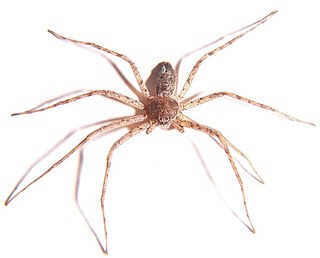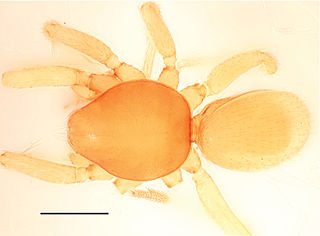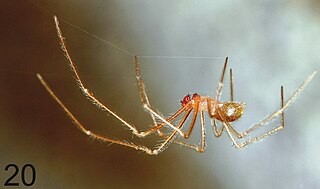
Philodromidae, also known as philodromid crab spiders and running crab spiders, is a family of araneomorph spiders first described by Tord Tamerlan Teodor Thorell in 1870. It contains over 600 species in thirty genera. Most are dull colored- brown, gray, yellowish or mottled with a leaf-like cardiac mark on the anterior dorsal abdomen, and seldom reach above 10 millimetres (0.39 in) long. None of the species build webs, but they do use silk for draglines and egg sacs.

Tord Tamerlan Teodor Thorell was a Swedish arachnologist.

Saitis barbipes is a common jumping spider found in the Mediterranean region.

Micrommata ligurina is a species of huntsman spider. It was first described by Carl Ludwig Koch in 1845.

Bannana is a genus of goblin spiders native to Xishuangbanna prefecture, Yunnan Province, China, where it lives in the leaf-litter of tropical rainforest. There are two known species: Bannana crassispina and B. parvula, both described in 2015. Individuals are pale yellow and unpatterned, and range from around 1.0 to 1.8 mm in body length, with females being slightly larger than males. The eyes are reduced or entirely absent. Known only from a nature reserve in Xishuangbanna, Bannana belongs to a group of Asian goblin spiders known as the "Dysderoides complex", that ranges from China to Pakistan and south to Indonesia.
Tengella is a genus of false wolf spiders that was first described by Friedrich Dahl in 1901. It is a senior synonym of Metafecenia.
Minotauria is a genus of Balkan woodlouse hunting spiders that was first described by Władysław Kulczyński in 1903. As of May 2019 it contains only two species: M. attemsi and M. fagei. In 1847, it was argued to be a synonym of Stalita.

Typhlonesticus is a genus of scaffold web spiders first described by Władysław Kulczyński in 1914. As of February 2019, it contains only five European species.
Carpathonesticus avrigensis is a species of araneomorph spider of the family Nesticidae. It occurs in Romania, where it was discovered in a cave. Only two specimens, a male and a female, are known.
Carpathonesticus fodinarum is a species of araneomorph spider of the family Nesticidae. It occurs in Romania, where it occurs in caves.
Carpathonesticus hungaricus is a species of araneomorph spider of the family Nesticidae. It occurs in Romania, where it inhabits caves.
Carpathonesticus lotriensis is an araneomorph spider species of the family Nesticidae. It occurs in Romania, where it can be found in caves.
Carpathonesticus mamajevae is an araneomorph spider species of the family Nesticidae. It occurs in Georgia, in the Lagodekhi Nature Reserve.
Carpathonesticus paraavrigensis is a species of araneomorph spider of the family Nesticidae. It occurs in Romania, where it was discovered in a narrow gorge, on the overhanging side.
Carpathonesticus puteorum is a species of araneomorph spider of the family Nesticidae. It is found in the Romanian caves at an altitude of 460 to 930 m.
Carpathonesticus simoni is an araneomorph spider species of the family Nesticidae. It occurs in Romania, where it can be found in caves. It was transferred from the genus Nesticus to Carpathonesticus in 1980 by Lehtinen and Saaristo.
Carpathonesticus spelaeus is an araneomorph spider species of the family Nesticidae. It occurs in Romania, where it can be found in caves and outdoors under calcareous blocks. It was transferred from the genus Nesticus to Carpathonesticus in 1980 by Lehtinen and Saaristo.
Carpathonesticus zaitzevi is an araneomorph spider species of the family Nesticidae that occurs in Georgia. It was transferred from the genus Nesticus to Carpathonesticus in 1996.
Pterotricha is a genus of ground spiders that was first described by Władysław Kulczyński in 1903.
Chrysilla guineensis is a species of jumping spider. It is endemic to Guinea. It was described in 2013 based on specimens collected from the Nimba Mountains.





